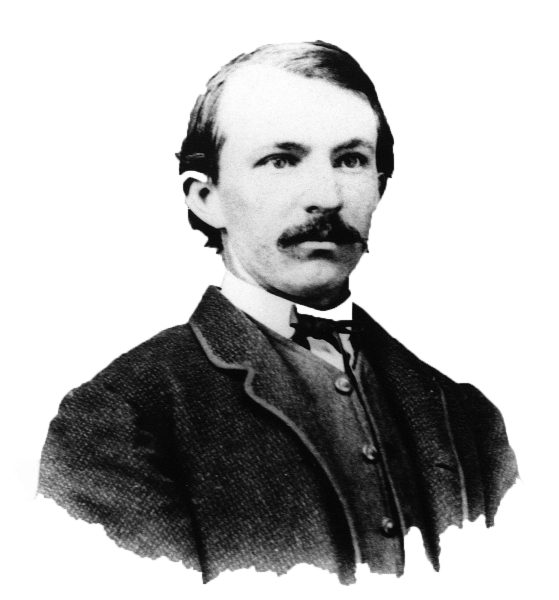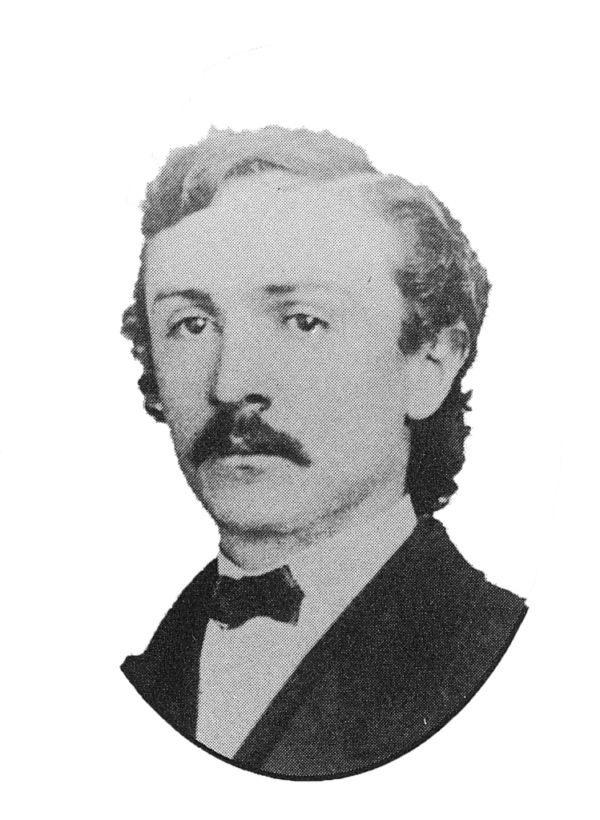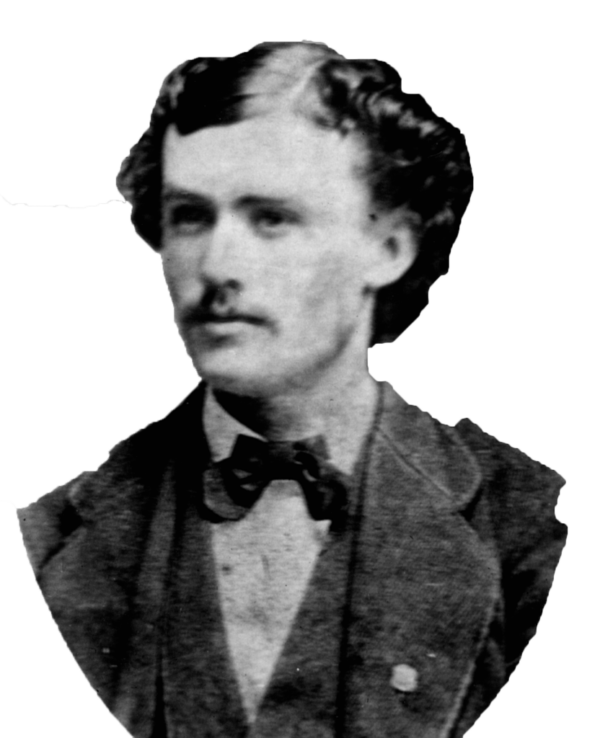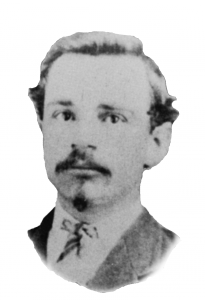 James Ward Wood was born on December 26, 1845, in rural Hardy County, Virginia (now in West Virginia). He was the fifth generation of Woods to farm the land near Lost River and his grandson Bill Wood, (who continues his KA legacy as an Alpha Chapter initiate) occupies the family land and the Woodlawn home today. Wood was apparently studying law when his part of Virginia entered the Civil War. He was blessed with a fantastic home library which was wide and varied. While his education was not as formal as we know today, he had a rich and broad base of learning. This was accomplished by his intense reading and study of all types of literature. As a young man, Wood was very dignified and deferential, engaging and friendly. In 1864, Wood joined Company F of the 7th Virginia Cavalry.
James Ward Wood was born on December 26, 1845, in rural Hardy County, Virginia (now in West Virginia). He was the fifth generation of Woods to farm the land near Lost River and his grandson Bill Wood, (who continues his KA legacy as an Alpha Chapter initiate) occupies the family land and the Woodlawn home today. Wood was apparently studying law when his part of Virginia entered the Civil War. He was blessed with a fantastic home library which was wide and varied. While his education was not as formal as we know today, he had a rich and broad base of learning. This was accomplished by his intense reading and study of all types of literature. As a young man, Wood was very dignified and deferential, engaging and friendly. In 1864, Wood joined Company F of the 7th Virginia Cavalry.
It was, in part, Lee’s acceptance of the presidency of Washington College, and a new job as the head master of the Ann Smith Academy for girls that caused the well-respected Reverend John A. Scott to move his family to Lexington in 1865. Rev. Scott’s family had once lived in Hardy County and was intimate with the Woods for two generations. Wood’s father recognized his son’s natural intellect and high moral character and sought to formalize his education. He also believed that his son would profit under the influence of the Rev. Scott, a Presbyterian minister respected throughout Virginia.
Wood made his way to Lexington and arrived on campus on October 10, 1865. He wrote home several days later, advising his brother that he “lodged in the College … in Room No. 4 of ‘Paradise’” (the name given by the students residing there to the building now known as Robinson Hall). Wood quickly became a member of the esteemed Washington Literary Society and was known for his poems and essays that appeared in the campus paper. He soon became known as the “College Bard” on campus. He also was known to enrich his conversations by quoting Biblical scripture and lines from literature. He was impressed with phrases that he had not heard before and sounded unique. Sometime before the close of the spring semester, Wood received permission from his father to leave campus and board about a mile away at Sunnyside, the residence of Will Scott’s aunt. It was while Wood was walking to school in the fall of 1866 that Samuel Zenas Ammen actually first met him. Ammen overheard Wood repeating a Latin phrase (which was the motto of Wood’s first ritual) and translated it for him. It was this phrase that Ammen later drew inspiration from to develop the great theme of Kappa Alpha Order. In an 1866 essay that Wood read to Alpha Chapter, he gives insight into his thoughts on the purpose of his young K.A. Fraternity: “Let us be just, charitable and good. Let us be great by the prayers of widows and orphans rather than by their tears and lamentations. Let us be of one mind and faith, let us banish all that is evil and cling to all that is good. Let us pull together and pull hard, but above all things let there be no doubt that we are pulling right.”
Because of the manner of his upbringing, Wood had a preference for activity and doing things that he enjoyed, at his own pace. Wood was not used to organized study. Ammen perceived Wood as “seeing the allegorical; the deep meaning; and, the symbolism” of things. Unfortunately, Wood did not take to the environment of a formal education that Robert E. Lee was shaping as the new president of Washington College. In January of 1867, Lee communicated to the Wood family that Ward Wood was not benefiting from his studies at Washington College. Accordingly, Wood was called home by his father and resigned his chapter office as Number III on January 25, 1867. On February 1, Wood called his brothers together at the main building of Washington College and made a departing speech and a small presentation to the fraternity that he helped create. Wood remained at home at Woodlawn until 1871, becoming a Master Mason in his local lodge in 1869. He then began travels in the West and migrated to Missouri where he took part in the Grange Movement. In 1875, he returned to Woodlawn where he raised blooded stock. He married at the age of 40 and eventually had eight children. In addition to being a farmer and rancher, Wood became a justice of the peace, school board president, county judge, surveyor, and notary public and representative in the West Virginia State Assembly. He died on January 7, 1926, and is buried in the Ivanhoe Presbyterian Church Cemetery in Lost River, West Virginia.
 William Nelson Scott was born in Houston, Virginia, on September 25, 1848. He was introduced to Wood by Rev. Scott, and the two young men became fast friends. He joined in Wood’s evolving effort during the fall of 1865 to form a new society on campus. When the group formally organized, Will Scott, because of his impressive personality, was personally selected by Wood to be the fraternity’s first president. He worked with Wood to guide the fledgling “lodge” through its trying first year. While it was Wood who first met S. Z. Ammen, it was Will Scott who convinced him to join the group of seven in October of 1866. Ammen said of Scott, “I have never seen any in equal to him in charm of voice, in solemnity of manner, in dignity of demeanor, or in general impressiveness in the initiatory customs.” Will Scott presided over Ammen’s initiation. After departing Washington College, Scott entered Union Theological Seminary, where he completed his study and became a Presbyterian minister in 1872. After heading a parish in Richmond, Virginia, for a few years, Scott moved to Galveston, Texas, where he led the First Presbyterian Church for nineteen years. During that time, he also served as a member of the Board of Trustees at Austin College. After surviving the Great Hurricane and Flood of 1900 that decimated the island and killed thousands, he returned to Staunton, Virginia, where he served as pastor of the Second Presbyterian Church until his death on June 3, 1919. Like Wood and the other founders, he also became a Freemason. He is buried in Hollywood Cemetery in Richmond, Virginia.
William Nelson Scott was born in Houston, Virginia, on September 25, 1848. He was introduced to Wood by Rev. Scott, and the two young men became fast friends. He joined in Wood’s evolving effort during the fall of 1865 to form a new society on campus. When the group formally organized, Will Scott, because of his impressive personality, was personally selected by Wood to be the fraternity’s first president. He worked with Wood to guide the fledgling “lodge” through its trying first year. While it was Wood who first met S. Z. Ammen, it was Will Scott who convinced him to join the group of seven in October of 1866. Ammen said of Scott, “I have never seen any in equal to him in charm of voice, in solemnity of manner, in dignity of demeanor, or in general impressiveness in the initiatory customs.” Will Scott presided over Ammen’s initiation. After departing Washington College, Scott entered Union Theological Seminary, where he completed his study and became a Presbyterian minister in 1872. After heading a parish in Richmond, Virginia, for a few years, Scott moved to Galveston, Texas, where he led the First Presbyterian Church for nineteen years. During that time, he also served as a member of the Board of Trustees at Austin College. After surviving the Great Hurricane and Flood of 1900 that decimated the island and killed thousands, he returned to Staunton, Virginia, where he served as pastor of the Second Presbyterian Church until his death on June 3, 1919. Like Wood and the other founders, he also became a Freemason. He is buried in Hollywood Cemetery in Richmond, Virginia.
 William Archibald Walsh was born in Richmond, Virginia, on September 11, 1849. Although Walsh was not present when Will Scott first joined in Wood’s idea of forming a new society, he soon was made aware of the idea and joined the effort. It was in Walsh’s dorm room that Wood and Scott spent time between classes. The friendship that was cemented focused the group. On December 21, 1865, Wood proposed a toast to the “two Williams” upon which they “swore together” to form a society. Wood wrote, “The principal work of thefirst year was done in Walsh’s room. Walsh was bright and capable, and he helped me a great deal, especially in connection with the badge.” Because Walsh’s family had resources, it is likely that he financed the first seven badges from Lexington jeweler D.M. Riley. After one year at Washington College, Walsh left in June of 1866 to take up his family’s business as a merchant. The first document revealing the name of the group as “K.A.” was issued to Walsh as a fees receipt in April of 1866. Walsh continued to correspond with Alpha Chapter, even after his departure, and is generally considered to be our first alumnus member. In 1874, Walsh became a Master Mason in Temple Lodge No. 9. Later that year, he traveled in Africa and returned home to Richmond in impaired health. He died in 1876 and also is buried in the Hollywood Cemetery.
William Archibald Walsh was born in Richmond, Virginia, on September 11, 1849. Although Walsh was not present when Will Scott first joined in Wood’s idea of forming a new society, he soon was made aware of the idea and joined the effort. It was in Walsh’s dorm room that Wood and Scott spent time between classes. The friendship that was cemented focused the group. On December 21, 1865, Wood proposed a toast to the “two Williams” upon which they “swore together” to form a society. Wood wrote, “The principal work of thefirst year was done in Walsh’s room. Walsh was bright and capable, and he helped me a great deal, especially in connection with the badge.” Because Walsh’s family had resources, it is likely that he financed the first seven badges from Lexington jeweler D.M. Riley. After one year at Washington College, Walsh left in June of 1866 to take up his family’s business as a merchant. The first document revealing the name of the group as “K.A.” was issued to Walsh as a fees receipt in April of 1866. Walsh continued to correspond with Alpha Chapter, even after his departure, and is generally considered to be our first alumnus member. In 1874, Walsh became a Master Mason in Temple Lodge No. 9. Later that year, he traveled in Africa and returned home to Richmond in impaired health. He died in 1876 and also is buried in the Hollywood Cemetery.
 Stanhope McClelland Scott, the younger brother of Will, was not enrolled in school during the fall of 1865. However, he was “soon enlisted as he would enter Washington College in January.” He was 15 years old at the time of our founding, making him the youngest founder. This occurrence set the minimum age for eligibility for membership in KA, which endures to this day. Stanhope graduated from Washington and Lee in 1871 and went on to study medicine at the University of Virginia. After receiving his medical license, he returned to his hometown to practice. Dr. Scott practiced medicine in western Maryland and northern West Virginia for over 50 years. He was the last of the four original founders to survive. He passed away on September 4, 1933, and is buried at Terra Alta, West Virginia. A leading member of the community, Stanhope was made a Mason in 1871, helped organize a lodge in Terra Alta and was elected its first Master.
Stanhope McClelland Scott, the younger brother of Will, was not enrolled in school during the fall of 1865. However, he was “soon enlisted as he would enter Washington College in January.” He was 15 years old at the time of our founding, making him the youngest founder. This occurrence set the minimum age for eligibility for membership in KA, which endures to this day. Stanhope graduated from Washington and Lee in 1871 and went on to study medicine at the University of Virginia. After receiving his medical license, he returned to his hometown to practice. Dr. Scott practiced medicine in western Maryland and northern West Virginia for over 50 years. He was the last of the four original founders to survive. He passed away on September 4, 1933, and is buried at Terra Alta, West Virginia. A leading member of the community, Stanhope was made a Mason in 1871, helped organize a lodge in Terra Alta and was elected its first Master.
Read about Samuel Zenas Ammen, our Practical Founder.
